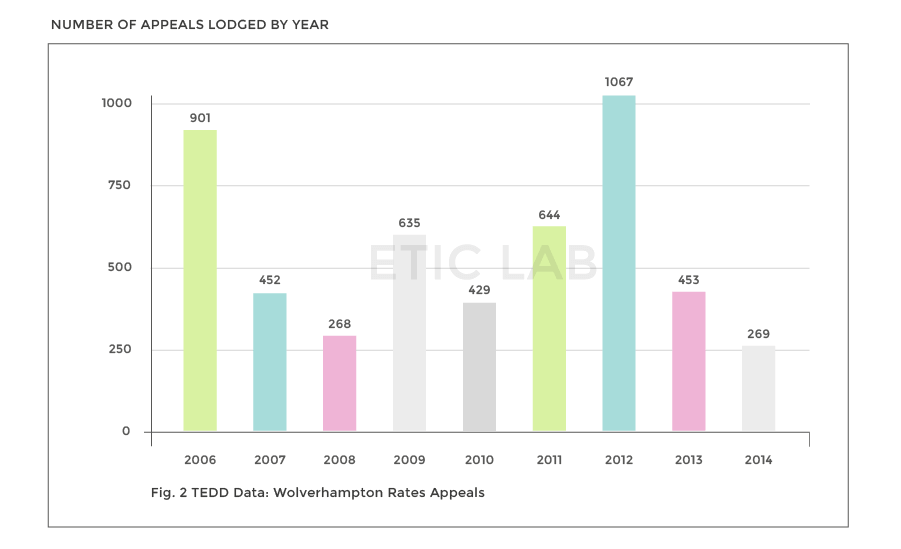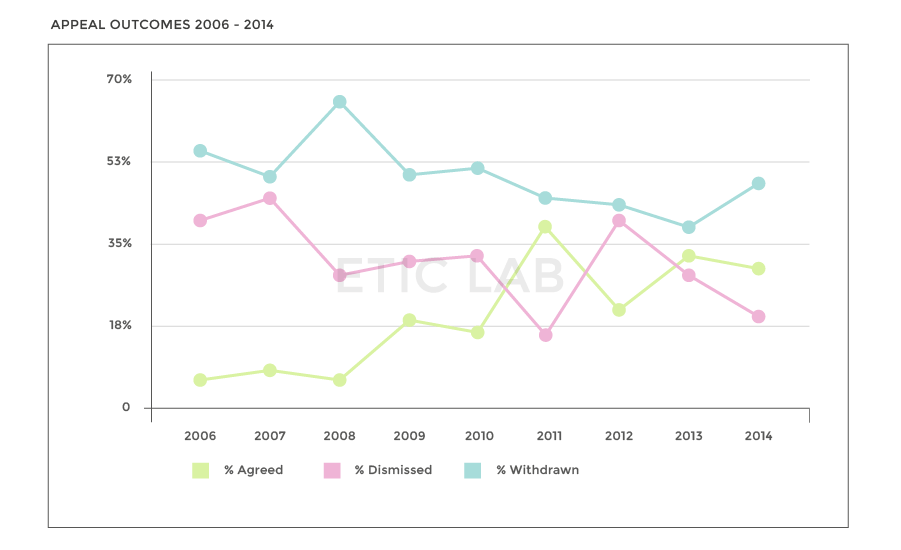The decisions of the Business Rates Tribunal involves hundreds of millions of pounds a year in tax revenue, and appeals provide a crucial revenue stream for many chartered surveyor practices and other businesses. Voila can be used to provide track the outcome of appeals, but also enables users to mine the dataset for other businesses which might be affected.
Appeals in One City
The City of Wolverhampton business community regularly appeal the Ratings Valuation of their premises – our data shows more than 3,000 appeals since 2010. These appeals will have had an impact on the Tax revenue of the City and of its business community. The dataset we have built provides a wealth of information for understanding this situation.

The number of appeals lodged varies very strongly by month with distinct peaks within the year. The system allows us to create and view a month-by-month breakdown of appeals for any or all years in the data record. We can see how the rate of new appeals varies within the year. Another factor in assessing the impact of the appeals is a clearer picture of the time taken to reach decisions and for an outcome of the appeal to be notified. Again our data show significant variation in the time taken to decide as a result of changes in the flow of work to the Valuation Office. The graph of the average time for decisions to be made is presented below (fig. 2) and shows that this figure has deteriorated severely in some years.
At present, the data series runs from 2006 until 2014 providing a comprehensive overview of trends and events such as the rates reviews in 2005 and 2010.
Along with data concerning the overall volume of appeals the dataset also allows for the creation of reports that identify the outcomes of the appeals lodged, this is very important because as the data shows, less than half of all appeals are successful and often that figure is much lower. The graph of outcomes provided in Figure 3 demonstrates both the low overall level of success of those lodging appeals and the significant role of the (early) dismissal of appeals.

It is in the relatively low proportion of successful appeals that shows how keen business ratepayers are to manage their business rates costs. A further set of data provided by our system shows the breakdown of appeals by the type of business premises involved and perhaps most important of all trends in the impact of appeals to the city regarding the decisions made and changes in the rateable values agreed.
It is clear from the dataset that the type of property predicts both the frequency of appeals and probability of a decision that results in a reduction in the rateable value of a property.
The data showed, for example, that appealing the rateable value of bank premises either retained by its original owner and remodelled or transferred to another type of business was frequently appealed. This led us to look at some common issues to examine the utility of Voila.

Using Voila to find businesses affected by Tribunal Decisions
Some Rating appeals in recent years have set precedents which can influence the outcome of launching successful appeals based along similar lines. We have looked at three examples to see if, with the use of TEDD, we could explore identify similar businesses with potential for savings:
1. Presence of a budget hotel chain in the immediate locality affecting the valuation of a private hotel.
2. Private schools affected by the outcome of a significant test case
3. Small businesses in multiple occupation tenancies
In case number 1, Voila allows a search box defined by longitude and latitude or an inventory of specific postcodes to be used as a filter for searching the database. Using this tool we were able to identify individual properties owned by a budget hotel chain and then set up a perimeter and create an output file of all of the private hotels located within a mile of the budget hotel.
In case number 2, Voila allows us to output a query of all Public Schools by location in England and structure the output regarding the rateable value of the locations.
In case number three, Voila allows us to search for multiple tenancies with a common or sub-divided address. In many cases, we can identify the companies located on the property as well as the responsible ratepayer.


